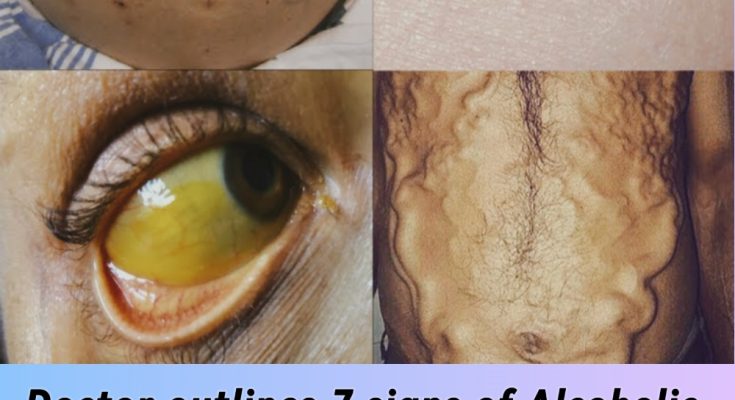Alcoholic Liver Disease (ALD) is a spectrum of liver conditions caused by excessive alcohol consumption, ranging from fatty liver (steatosis) to alcoholic hepatitis and, finally, cirrhosis, which is irreversible scarring of the liver. While early stages might have vague or no symptoms, as the disease progresses, more distinct and serious signs emerge due to the liver’s impaired function.
Here are 7 significant signs of advanced Alcoholic Liver Disease that doctors look for:
- Jaundice: This is one of the most classic signs of liver dysfunction. It’s the yellowing of the skin, whites of the eyes (sclera), and mucous membranes. It occurs because the damaged liver can’t properly process bilirubin, a yellow pigment that’s a waste product from red blood cell breakdown, leading to its buildup in the blood.
- Ascites: This is the accumulation of fluid in the abdominal cavity, causing the belly to swell and distend. It happens when the liver can no longer produce enough albumin (a protein that helps keep fluid in the bloodstream) and also due to increased pressure in the veins that carry blood to the liver (portal hypertension).
- Caput Medusae: A striking and less common sign, Caput Medusae refers to the appearance of distended and engorged superficial veins radiating outwards from the belly button on the abdomen. This is a direct result of severe portal hypertension, where blood flow through the scarred liver is obstructed, forcing blood to find alternative routes through smaller veins, which then become visibly swollen. The pattern can resemble the head of Medusa from Greek mythology.
- Spider Angiomas (or Spider Nevi): These are small, spider-like blood vessels that appear on the skin, typically on the face, neck, chest, and arms. They consist of a central red spot with tiny blood vessels radiating outwards like spider legs. They are thought to be related to hormonal imbalances due to the liver’s inability to metabolize hormones properly.
- Palmar Erythema (Red Palms): This refers to a distinct redness or blotchiness on the palms of the hands, particularly on the eminences at the base of the thumb and little finger. Like spider angiomas, it’s believed to be related to altered hormone metabolism.
- Hepatic Encephalopathy (Confusion, Memory Problems, Asterixis): As the liver becomes severely damaged, it can no longer effectively filter toxins (like ammonia) from the blood. These toxins then build up and travel to the brain, affecting brain function. Symptoms can range from mild confusion, forgetfulness, and personality changes to severe disorientation, slurred speech, drowsiness, and even coma. Asterixis, also known as “flapping tremor,” is a characteristic physical sign where the hands briefly “flap” involuntarily when the arms are outstretched and wrists are bent back.
- Easy Bruising and Bleeding: The liver produces various proteins essential for blood clotting. When the liver is damaged, it can’t produce enough of these clotting factors, leading to a tendency to bruise easily, have prolonged bleeding from minor cuts, or even experience internal bleeding (e.g., from esophageal varices, which are enlarged veins in the esophagus that can rupture due to portal hypertension).
Other common signs that may accompany these:
- Fatigue and Weakness: Persistent tiredness and lack of energy.
- Loss of Appetite and Weight Loss: Due to nausea, general malaise, and impaired nutrient absorption.
- Nausea and Vomiting: Common gastrointestinal symptoms.
- Muscle Wasting: Loss of muscle mass, often noticeable in the limbs and face.
- Dark Urine and Pale Stools: Related to bilirubin processing issues.
- Itchy Skin (Pruritus): Due to the buildup of bile salts under the skin.
- Edema (Swelling in Legs and Ankles): Similar to ascites, but fluid accumulates in the lower extremities.
- Gynecomastia (in men): Enlarged breasts in men due to hormonal imbalances.
- Testicular Atrophy (in men): Shrinkage of the testicles.
Important Note: Alcoholic Liver Disease often does not show obvious symptoms until it has reached an advanced stage, such as alcoholic hepatitis or cirrhosis. If you or someone you know has a history of heavy alcohol consumption and is experiencing any of these symptoms, it is crucial to seek immediate medical attention. Early diagnosis and, most importantly, complete abstinence from alcohol are critical for managing the disease and preventing further damage.

